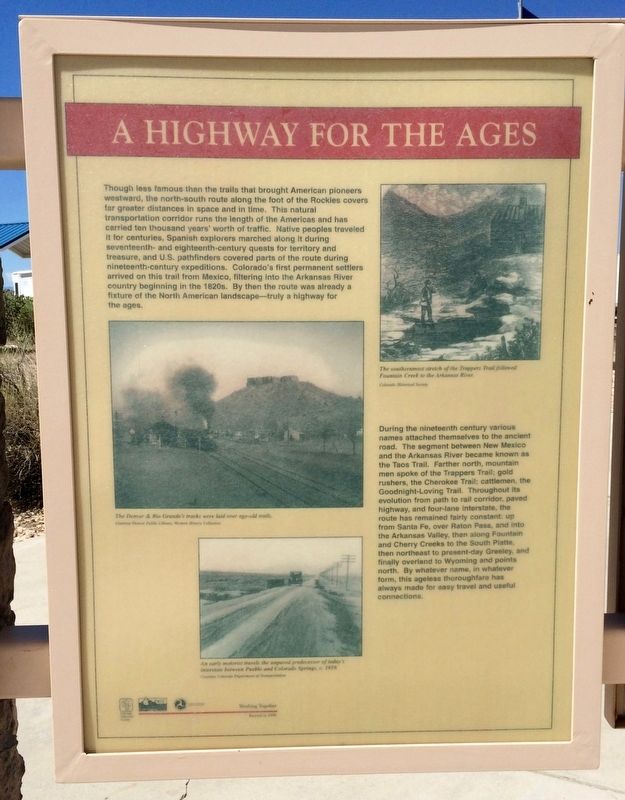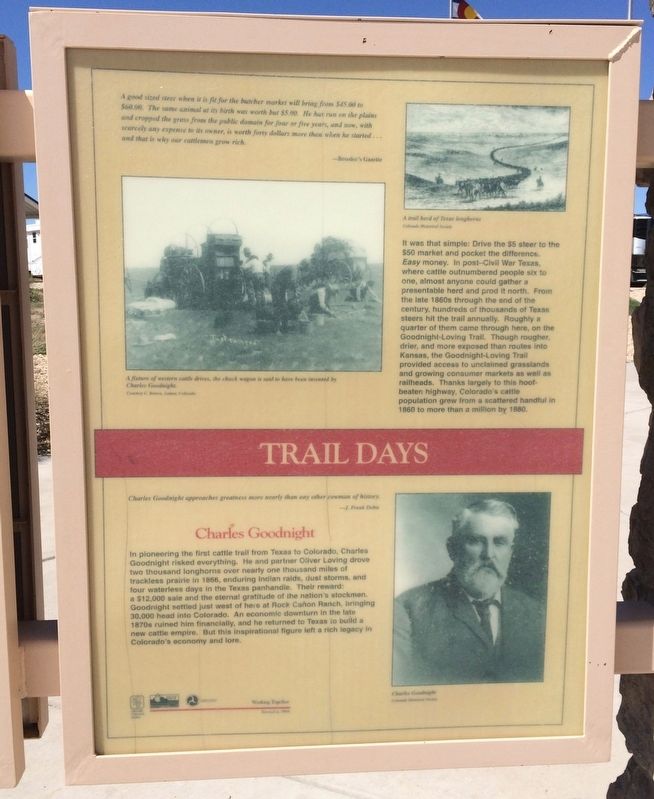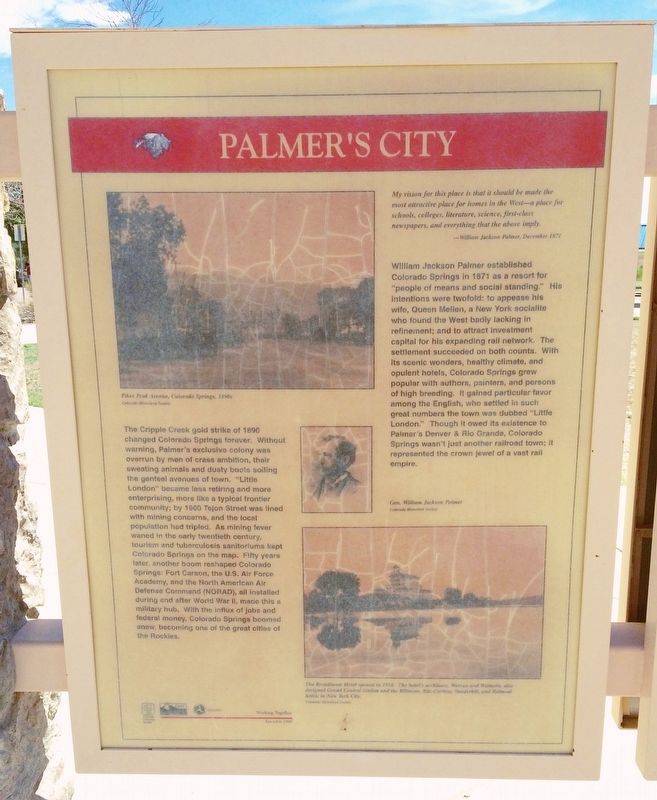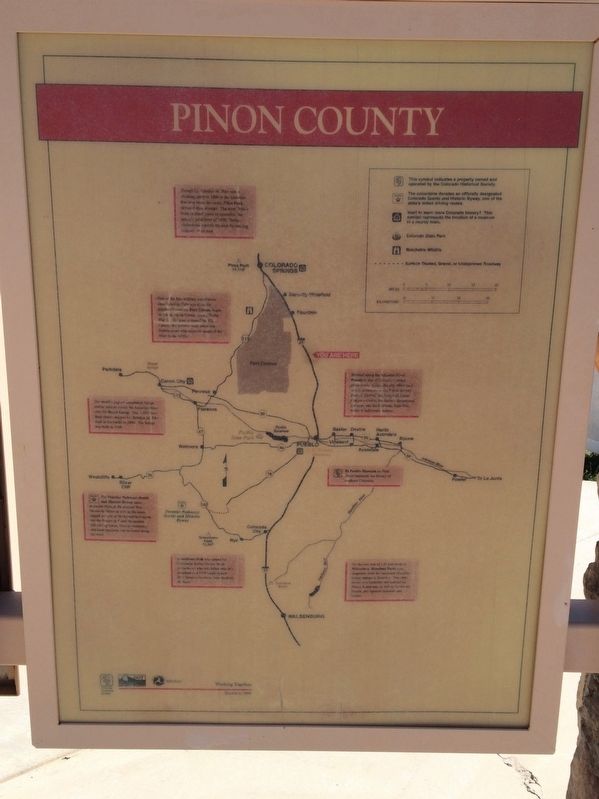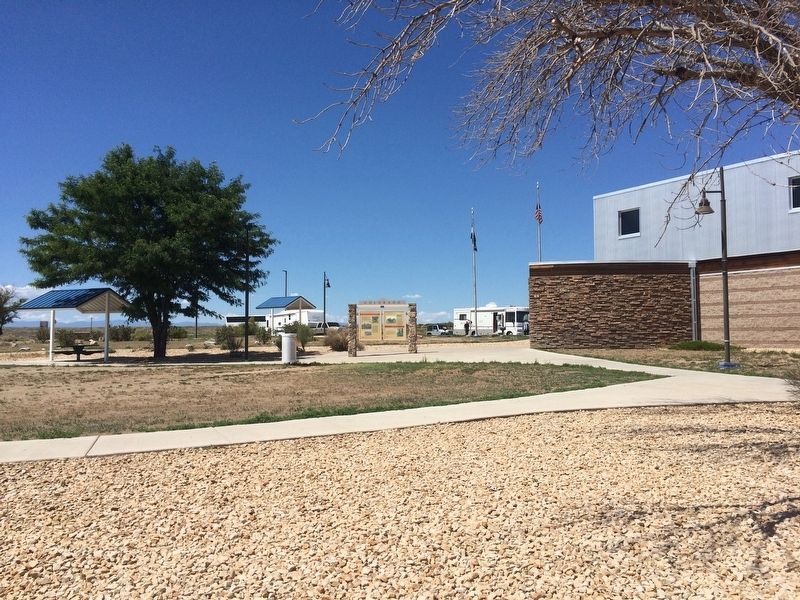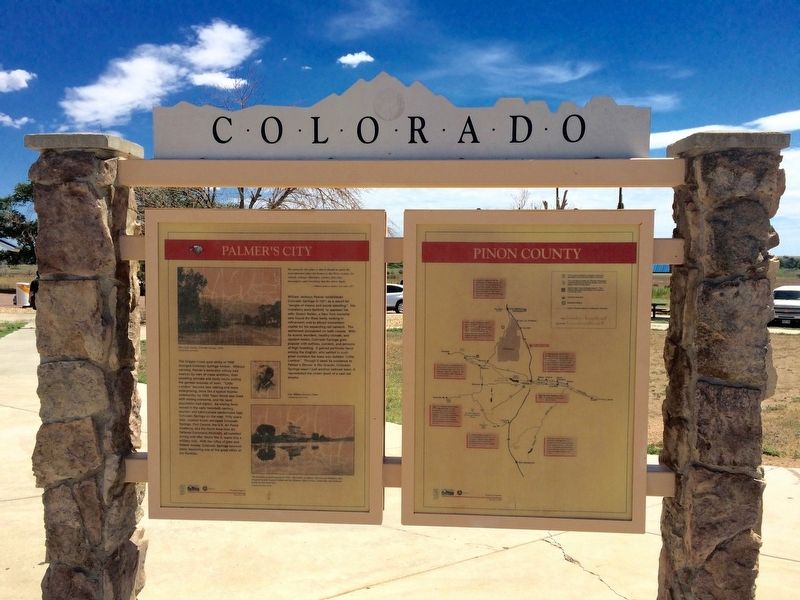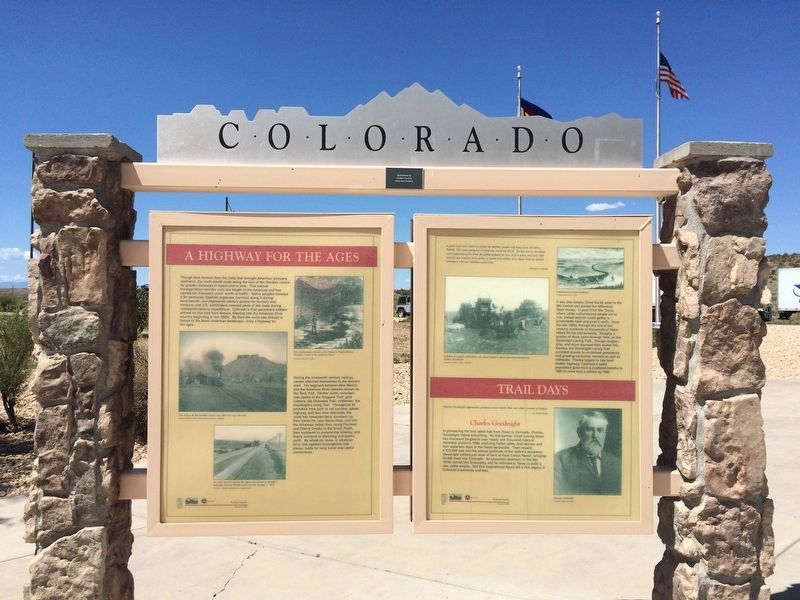Near Pueblo in Pueblo County, Colorado — The American Mountains (Southwest)
A Highway for the Ages - Trail Days / Palmer's City - Pinon County
Panel 1
Though less famous than the trails that brought American pioneers westward, the north-south route along the foot of the Rockies covers far greater distances in space and in time. This natural transportation corridor runs the length of the Americas and has carried ten thousand years' worth of traffic. Native peoples traveled it for centuries, Spanish explorers marched it during seventeenth- and eighteenth-century quests for territory and treasure, and U.S. pathfinders covered parts of the route during nineteenth-century expeditions. Colorado's first permanent settlers arrived on this trail from Mexico, filtering into the Arkansas River country beginning in the 1820s. By then the route was already a fixture of the North American landscape - truly a highway for the ages.
During the nineteenth century various names attached themselves to the ancient road. The segment between New Mexico and the Arkansas River became known as the Taos Trail. Farther north mountain men spoke of the Trapper's Trail; gold rushers, the Cherokee Trail; cattlemen, the Goodnight-Loving. Throughout its evolution from path to rail corridor, paved highway, and four-lane interstate, the route has remained fairly constant: from Santa Fe over Raton Pass into the Arkansas Valley, along Fountain and Cherry Creeks to the South Platte, then downstream to present-day Greeley, finally overland to Wyoming and points north. By whatever name, in whatever form, this ageless thoroughfare has always made for easy travel and useful connections.
Also found on this panel:
Drawing of two men alongside a creek
(Caption) The southernmost stretch of the Trappers' Trail followed Fountain Creek to the Arkansas River.
Colorado Historical Society
Photo of train
(Caption) The Denver & Rio Grande's tracks were laid over age-old trails.
Courtesy Denver Public Library, Western History Department
Photo of car
(Caption) An early motorist (circa 1919) travels the unpaved predecessor of today's interstate between Pueblo and Colorado Springs.
Courtesy Colorado Department of Transportation
Panel 2
"A good sized steer when it is fit for the butcher market will bring from $45.00 to $60.00. The same animal at its birth was worth but $5.00. He has run on the plains and cropped the grass from the public domain for four or five years, and now, with scarcely any expense to its owner, is worth forty dollars more than when he started....and that is why our cattlemen grow rich." - undated item, Breeder's Gazette
It was that simple: drive the $5 steer to the $50 market and pocket the difference. Easy money. In post-Civil War Texas, where cattle outnumbered people six to one, almost anyone could cobble together a presentable herd and prod it north. From the late 1860s through the end of the century, hundreds of thousands of Texas steers hit the trail annually. Roughly a quarter of them came through here, on the Goodnight-Loving Trail. Though rougher, drier, and more exposed than routes into Kansas, the Goodnight-Loving Trail provided access to unclaimed grasslands and growing consumer markets as well as railheads. Thanks largely to this hoof-beaten highway, Colorado's cattle population grew from a scattered handful in 1860 to more than a million by 1880.
Charles Goodnight
"Charles Goodnight approaches greatness more nearly than any other cowman of history." - J. Frank Dobie, Cow People
In pioneering the first cattle trail from Texas to Colorado, Charles Goodnight risked everything. He and partner Oliver Loving drove 2,000 longhorns over nearly one thousand miles of trackless prairie in 1866, enduring Indian raids, dust storms, and four waterless days in the Texas panhandle. Their reward: a $12,000 sale and the eternal gratitude of the nation's stockmen. Goodnight settled just west of here at Rock Canon Ranch, bringing 30,000 head into Colorado. An economic downturn in the late 1870s ruined him financially, and he returned to Texas to build a new cattle empire. But this inspirational figure left a rich legacy in Colorado's economy and lore.
Also found on this panel:
Drawing of cattle drive
(Caption) A trail herd of Texas Longhorns
Colorado Historical Society
Photo of chuck wagon
(Caption) A fixture of Western cattle drives, the chuck wagon is said to have been invented by Charles Goodnight.
Courtesy C. Bowen, Lamar, Colorado
Portrait of Goodnight
(Caption) Charles Goodnight
Colorado Historical Society
Panel 3
"My vision for this place is that it should be made the most attractive place for homes in the West - a place for schools, colleges, literature, science, first-class newspapers, and everything that the above imply." - William Jackson Palmer, December 1871
William Jackson Palmer established Colorado Springs in 1871 as a resort for "people of means and social standing." His intentions were twofold: to appease his wife, Queen Mellen, a New York socialite who found the West badly lacking in refinement; and to attract investment capital for his expanding rail network. The settlement succeeded on both counts. With its scenic wonders, healthy climate, and opulent hotels, Colorado Springs grew popular with authors, painters, and persons of high breeding. It gained particular favor among the English, who settled in such great numbers the town was dubbed "Little London." Though it owed its existence to Palmer's Denver & Rio Grande, Colorado Springs wasn't just another railroad town; it represented the crown jewel of a vast rail empire.
The Cripple Creek gold strike of 1890 changed Colorado Springs forever. Without warning, Palmer's exclusive colony was overrun by men of crass ambition, their sweating animals and dusty boots soiling the genteel avenues to town. "Little London" became less retiring and more enterprising, more like a typical frontier community; by 1900 Tejon Street was line with mining concerns and the local population had tripled. As mining fever waned in the early twentieth century, tourism and tuberculosis sanatoriums kept Colorado Springs on the map. Fifty years later, another boom reshaped Colorado Springs: Fort Carson, the U.S. Air Force Academy, and the North American Air Defense Command (NORAD), all installed during and after World War II, made this a military hub. With the influx of jobs and federal money, Colorado Springs boomed anew, becoming one of the great cities of the Rockies.
Also found on this panel:
Photo of Pike Peak Avenue, Colorado Springs, 1890s
Colorado Historical Society
Photo of Gen. William Jackson Palmer
Colorado
Historical Society
Photo of the Broadmoor
(Caption) The Broadmoor Hotel opened in 1918. The hotel's architects also designed Grand Central Station, and the Ritz-Carlton, Vanderbilt, and Belmont hotels in New York City.
Colorado Historical Society
Panel 4
Erected 1998 by Colorado Historical Society. (Marker Number 219.)
Topics and series. This historical marker is listed in these topic lists: Animals • Notable Places • Roads & Vehicles • Settlements & Settlers. In addition, it is included in the Colorado - History Colorado series list. A significant historical month for this entry is December 1871.
Location. 38° 30.009′ N, 104° 37.511′ W. Marker is near Pueblo, Colorado, in Pueblo County. Marker can be reached from Interstate 25 at milepost 115,, one mile north of Young Hollow Road (Exit 114) when traveling north. Located in the northbound I-25, Colorado Department of Transportation rest area. Touch for map. Marker is in this post office area: Pueblo CO 81008, United States of America. Touch for directions.
Other nearby markers. At least 2 other markers are within 14 miles of this marker, measured as the crow flies. Pueblo - Trail Days / Industrial Frontier - Pinon County (approx. 3.4 miles away); Pueblo West Veterans Memorial (approx. 13.6 miles away).
Credits. This page was last revised on September 12, 2016. It was originally submitted on September 12, 2016, by Mark Hilton of Montgomery, Alabama. This page has been viewed 510 times since then and 11 times this year. Photos: 1, 2, 3, 4, 5, 6, 7. submitted on September 12, 2016, by Mark Hilton of Montgomery, Alabama.
